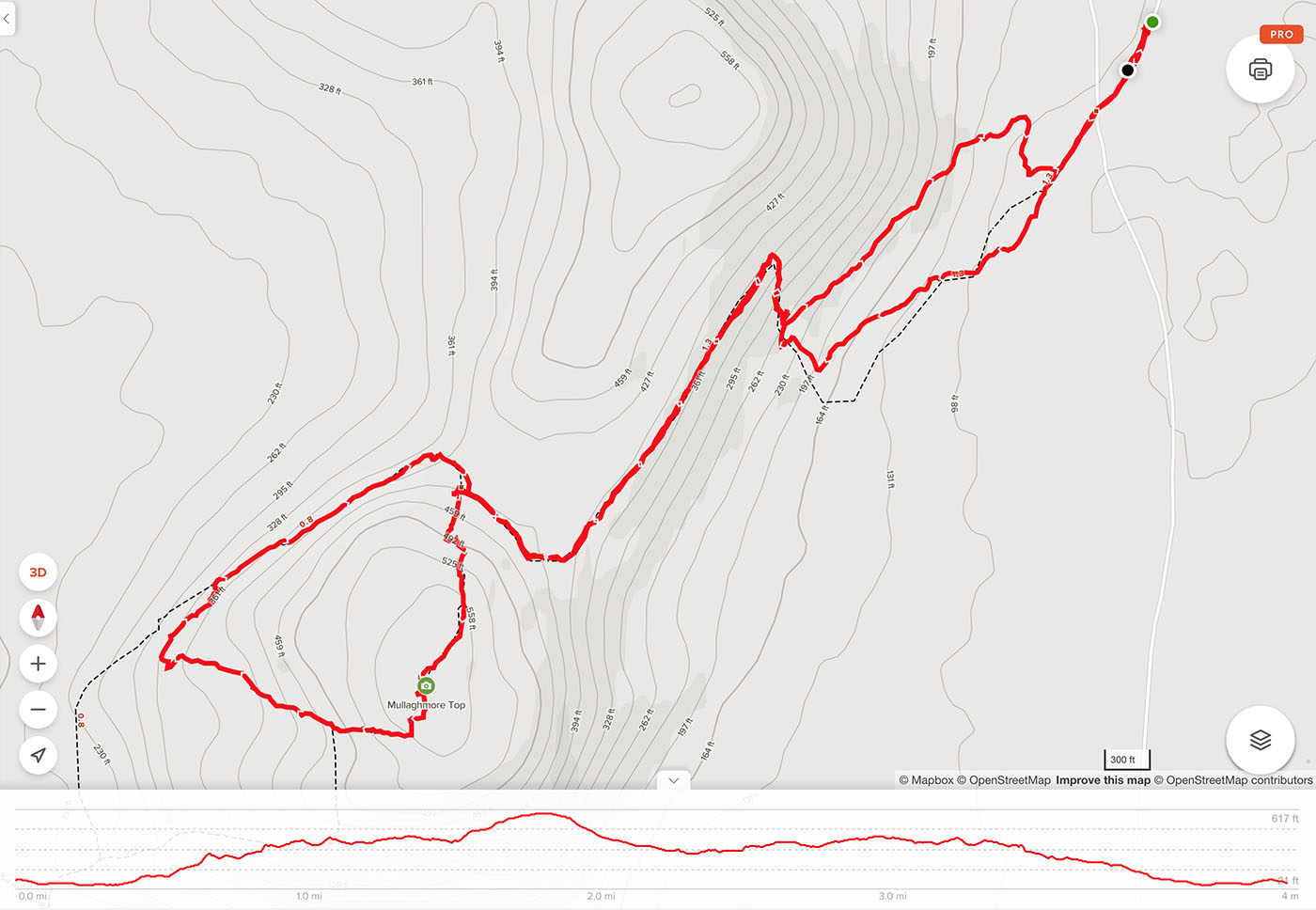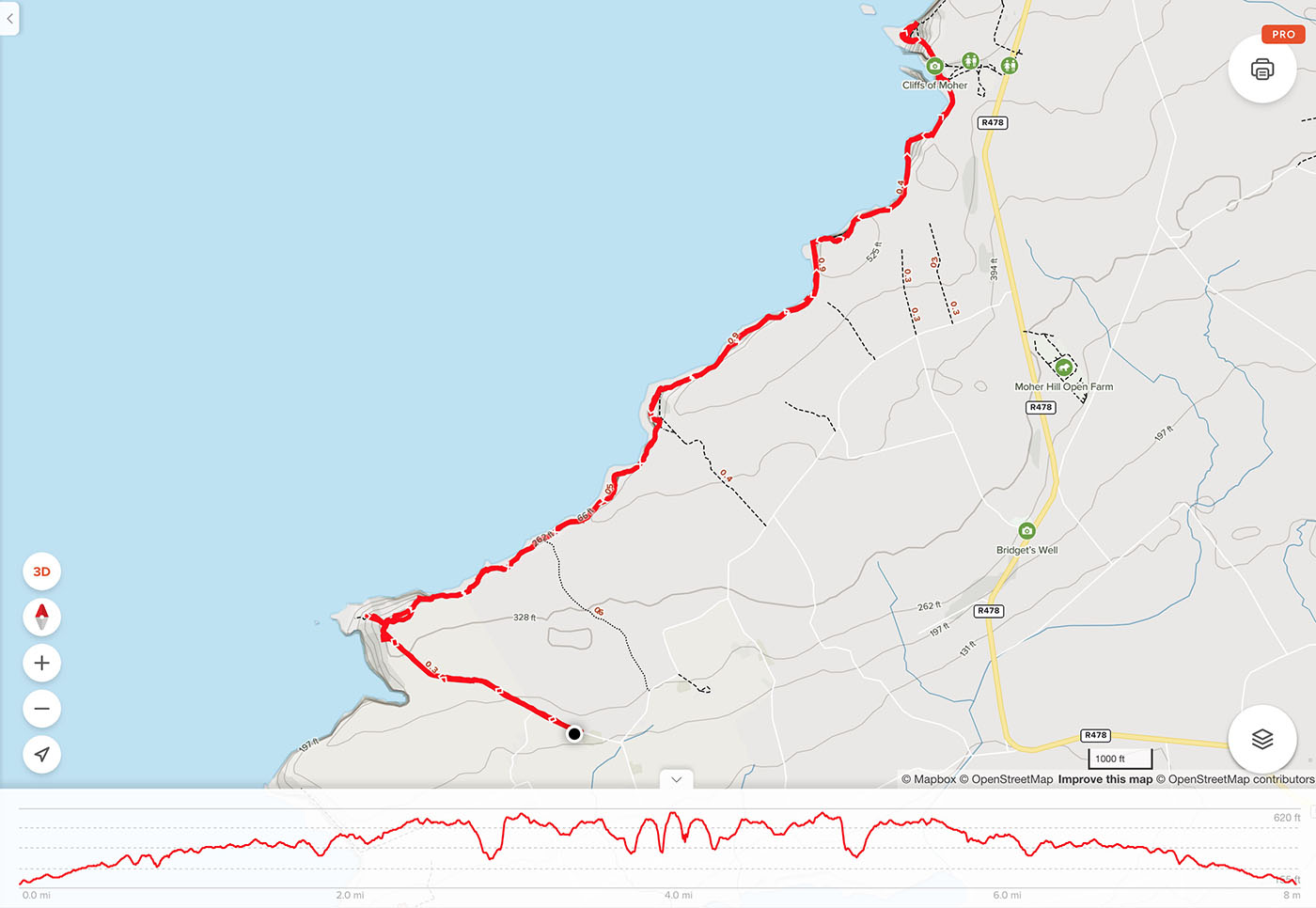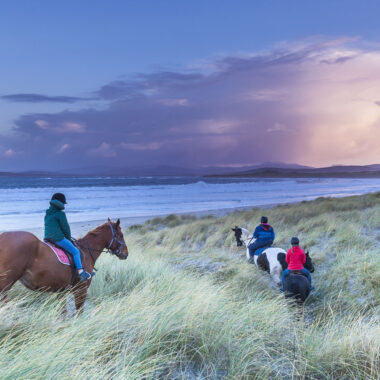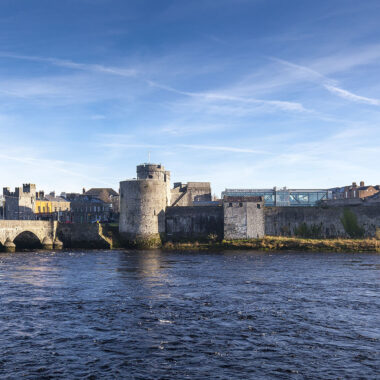The kids were in heaven staying on a cattle farm near the sleepy village of Kilfenora in central County Clare for a few days: 50 head of cattle to feed each day, a couple of adorable Border Collies (Bramble and Heidi) to follow them around the farm, and a handful of calves to corral. We arrived in Kilfenora late in the afternoon, but the kids were put to work immediately by the patriarch of the farm Martin, who had Max pitch forking silage to the cows until dinnertime. It was fun to have a chat to Martin – who had a mouth on him that made even me blush (fortunately his accent was so thick the kids probably couldn’t understand the bulk of the expletives) – who was one in a long line of his family who’d farmed the property where we stayed. His grandmother was one of 14 children, 12 of which had emigrated to the United States when they were younger. The farm had historically produced both beef and milk, but the dairy portion was mothballed years ago, and when we stayed Martin was turning out grass-fed Angus and Irish Reds for beef. The cows received a lot of human contact so were quite friendly, it was a fun place to spend a few days, I’m sure one of the kids’ favorites.
The house where we stayed was built at the beginning of the nineteenth century and renovated into a farmstay about 20 years ago. The walls in some portions were incredible, at least three feet of solid stone. It was the first time I’d ever burned peat – or turf as they call it in Ireland – in a fireplace: Martin and his lovely wife Marian would harvest the peat from their fields, dry it during the summer and then cut it into log-shaped pieces to burn. The peat in Ireland and the UK is a huge carbon sink, and farmers removing it are often targets of the Greta Thunbergs of the world. But land covered in peat is impossible to farm so it’s effectively a survival practice for the bulk of farmers with peat-covered land. Either way, it was an excellent fuel to keep us warm in the cold of the late autumn weather.
On our last morning the car was packed and ready to go but we couldn’t find Lilia. As we were walking around the farm looking for her, Marian let us know that she’d gone off on the tractor with Martin. She rolled up the driveway about 15 minutes later hanging out of the tractor cab. When we asked her where she’d been, she let us know she’d been helping Martin feed the cattle on another portion of the ranch and riding the ranch horse bareback! Marian and Martin were absolutely exceptional hosts, salt of the earth people, it was lovely to meet them and enjoy their little slice of paradise for a few days.
I was incredulous at how few of the pubs around County Clare were open for business during our time in the area. It was actually quite difficult to find somewhere to grab dinner within 30 minutes of Kilfenora. Kilfenora itself had a couple of pubs, but both were closed during our visit, and even larger towns close by like Ennistimon only had a handful of takeout offerings from which to choose. It was quite unfortunate, as the Irish are such musical people, and the pubs in County Clare are known for their set dancing. Not sure if it was COVID or winter or just the local economy, but it was unlike anywhere else we’d been in Europe when it came to local eats. I’m not complaining: our house on the farm was exceedingly well provisioned, so we enjoyed a couple of meals at home as well as some exceptional fish and chips from Liscannor Bay Seafood Takeaway (without a doubt the best we’d had since arriving in the UK/Ireland).
Galway – the fifth largest city in the Republic of Ireland – was about an hour in the car from the farm in Kilfenora. Its pedestrian-only streets and the Sunday market full of knick-knacks were fun to explore. There were some beautiful examples of Irish-made woolen goods on show and plenty of stores where we all were able to do a spot of Christmas browsing. The buskers on Shop Street performing in the misting rain were enjoyed by us all, and the kids finally managed to get hold of some advent calendars for the Christmas season at one of the newsagents in town. Even in Galway, with its population of almost 100K, so many of the restaurants were operating on a take away basis due to COVID. I think Ireland has got to be up there with Austria as the most COVID-wary country we’ve set foot in thus far.
Burren National Park was a short drive from our digs in Kilfenora, a spot our host Martin highly recommended we visit. The national park’s mind-bending limestone formations through which the hiking trails ran covered the landscape in every direction, it was a little like a moonscape with the rocks covering the earth and the absence of any trees. Unlike the bulk of Ireland – which is covered in grass and moss growing on the endless masses of peat – the Burren’s limestone was littered with an incredible diversity of wildflowers, ferns and grasses. According to Martin, the beef and lamb produced by farmers that graze their herds on the limestone is the most prized in Ireland, the diversity of plant life responsible for producing the country’s best meat. We came across a handful of massive Charolais cows as we were hiking, quite friendly ladies but easily the biggest cows I think I’d ever seen. The views of the limestone hills stretching to the north from the peak of Mullaghmore Top were very impressive, it looked as if some higher being had extruded the hills out of a giant Play-Doh gun. It was an educational adventure for the kids, as the park brochure taught them about the historical formation of the limestone and they were able to spot fossilized coral in some of the rocky crags. It was unlike any landscape I’d ever seen.
The Cliffs of Moher were a hotspot on the tourist trail along the Wild Atlantic Way. For movie buffs out there: the cliffs are depicted as the the Cliffs of Insanity in the 1987 classic The Princess Bride. At their peak, the cliffs drop more than 700 feet/200 meters into the Atlantic, and provide unparalleled views of the Aran Islands on a clear day. We hiked along the clifftops from Hag’s Head during our time in County Clare, the trail hugging the edge of the precipice – at times perilously closely – for the entire route of our almost eight mile/13 kilometer walk. Hag’s Head at the southern end of the cliffs was surrounded by farmland, where we parked in a farmer’s driveway for a few euros and enjoyed the trail entirely to ourselves. The visitor center at the northern turnaround part of our walk, however, was busy with cars and tour buses. The Irish government has latched onto the cliffs and created an exceedingly touristy experience, where visitors fork over 10€ per person to park at the visitor center and make the short stroll to the edge of the cliffs. The views near the visitor center and O’Brien’s Tower were impressive, but we all unanimously favored the vistas from the southern portion of the cliffs by Moher Tower at Hag’s Head. Such rugged landscape, the sound of the waves smashing against the base of the cliffs was a constant reminder of the ferocity of the sea below. There were some stunning views during our hike, but for me the climb we did to the peak of Slieve League in County Donegal was much more impressive.
Our hikes in Ireland and the UK have often been shared with livestock, as part of which we’ve routinely experienced close fraternizing between male and female animals. As the kids have noticed males with their lipstick out on a few occasions, the questions – especially from Max – about the birds and the bees have inevitably followed. When we’re walking together for hours at a time there’s really no diverting the awkward questions about the origins of babies, and our walk atop the cliffs was the most in depth discussion by far. I do need to thank Lisa for educating young Max during our hike along the Cliffs of Moher, responding to his inquiry about sheep using their lipstick and whether humans have to do the same to make babies with a full-fledged chat about reproduction. I overheard quite a few hilarious queries as part of Max’s rapid-fire questioning – where the lipstick goes, if it happens automatically, does it hurt – but I think the funniest was probably one at the end: “Wait, did Daddy have to do that to you to make us?! I’m never having kids!” I guess he’ll be ahead of the game when it comes to learning about it in school…

















































































Kilfenora, so reminiscent of farmboy days, age 8-13. Even the dog, Bramble, a resemblance of Rusty. Good job with the chapter lesson on reproduction and geology, “If you Wish”.
It looks like you again have pretty decent weather, especially considering it is December. You must be buddies with the weather gods.
I agree, I think we’ve generally been quite lucky through the UK and Ireland. We could have been rained out the entire time!